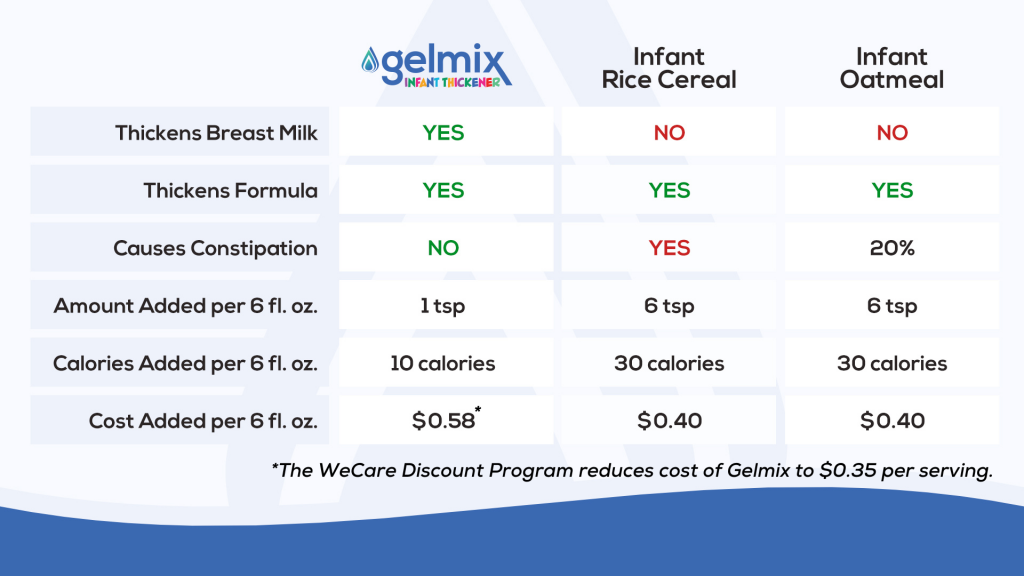Thickening Feeds is Recommended for Infants with Reflux
According to current NASPGHAN-ESPGHAN Pediatric Gastroesophageal Reflux Clinical Practice Guidelines, thickening infant feeds is suggested as a first-line approach for infants with recurrent regurgitation or spit-ups (GER or GERD).

Thicken Breast Milk with a Carob Bean Gum Thickener
Continuing breast feeding is encouraged for infants with reflux. Pumped breast milk can be thickened with a carob bean gum thickener, like Gelmix Infant Thickener. Breast milk cannot be thickened with cereals. Amylases in the breast milk digest the cereals, making it thin and ineffective at reducing spit-ups. Click here for a printable guide to thickening breast milk when recommended for reducing spit-ups.
Thicken Formula with Gelmix or Cereals
Formulas can be thickened with a carob bean gum thickener, like Gelmix Infant Thickener, or with infant cereals, like rice cereal or oatmeal. Cereals add a lot of calories and carbohydrates, displacing the formula significantly with starch. Cereals also tend to cause constipation. Click here for a printable guide to thickening formulas with Gelmix when recommending for reducing spit-ups.
Considering Costs
Gelmix is typically more expensive than cereals. To help with those added costs, Gelmix offers a discount program for families in need. If you have Medicaid, and thickeners are not covered in your state, apply for the WeCare program. You just need a referral from your physician and proof of Medicaid to apply.
Smaller, more frequent feedings and continuing breast feeding are also recommended in the NASPGHAN-ESPGHAN Pediatric Gastroesophageal Reflux Clinical Practice Guidelines. Studies support these guidelines and show that thickening breast milk or formula decrease regurgitation episodes. Thickened feeds are typically well tolerated by infants and young children. Talk to your pediatrician first before thickening your infant’s diet.
References:
Duncan, Daniel R., Kara Larson, and Rachel L. Rosen. “Clinical aspects of thickeners for pediatric gastroesophageal reflux and oropharyngeal dysphagia.” Current gastroenterology reports 21 (2019): 1-9.
Georgieva, Miglena, et al. “Effects of carob-bean gum thickened formulas on infants’ reflux and tolerance indices.” World journal of clinical pediatrics 5.1 (2016): 118.
Koo, Jenny K., et al. “Through thick and thin: the in vitro effects of thickeners on infant feed viscosity.” Journal of Pediatric Gastroenterology and Nutrition 69.5 (2019): e122-e128.
Rosen, Rachel, et al. “Pediatric gastroesophageal reflux clinical practice guidelines: joint recommendations of the North American Society for Pediatric Gastroenterology, Hepatology, and Nutrition (NASPGHAN) and the European Society for Pediatric Gastroenterology, Hepatology, and Nutrition (ESPGHAN).” Journal of pediatric gastroenterology and nutrition 66.3 (2018): 516.